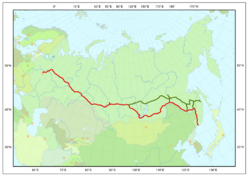Baikal Amur Mainline
The Baikal-Amur Mainline (Russian Байкало-Амурская Магистраль, Baikalo-Amurskaya Magistral’, BAM) is a railway line in Russia. Traversing Eastern Siberia and the Russian Far East, the 4,234 km (2,305 mile) long BAM runs about 380 to 480 miles north of and parallel with the Trans-Siberian railway.
The BAM was built as a strategic alternative route to the Trans-Siberian Railway, especially to the vulnerable sections close to the border with China. BAM's costs were estimated at $14 billion, and it was built with special, durable tracks since much of it was built over permafrost.
History
The route of the present-day BAM was first considered in the 1880s as an option for the eastern section of the Trans-Siberian railway.
The section from Tayshet to Bratsk was built in the 1930s. Most of the Far Eastern section was built during the years of 1944-1946, mainly by gulag prisoners, including German and Japanese prisoners of war, of whom possibly as many as 150,000 died.[citation needed] In 1953, following Stalin's death, virtually all construction work on the BAM stopped and the line was abandoned to the elements for more than twenty years.
In March 1974, Soviet General Secretary Leonid Brezhnev stated that a new BAM project would become a huge Komsomol undertaking. Brezhnev famously stated that "BAM will be constructed with clean hands only!" and firmly rejected the suggestion to use prison labor again. The USSR described BAM as "the construction project of the century." In September 1984, a "golden spike", akin to one used in Utah in 1867, was hammered into place, connecting the eastern and western sections of the BAM. The Western media was not invited to attend this historic event as Soviet officials did not want any comments about the line's operational status and working conditions of the construction workers. In reality, only one third of the BAM's track was fully operational for civilians, due to military reasons.
At least 60 boomtowns developed around the route of BAM.
BAM was again declared complete in 1991. By then, the total cost to build the line was 14 billion US dollars.
A recent major improvement was the opening of the 15.343 km Severomuisk Tunnel on December 5, 2003. Up to 1.5 km deep, the tunnel is one of the longest railway tunnels in the world. Construction took twenty-seven years to complete. Prior to this, the corresponding route segment was 54km long, with heavy slopes necessitating auxiliary locomotive.
The railway now attracts thousands of Western railway enthusiasts each year.
Route
The BAM departs from the Trans-Siberian railway at Tayshet, then crosses the Angara River at Bratsk, crosses the Lena river, proceeds past Severobaikalsk at the northern tip of Lake Baikal, past Tynda and Khani, crosses the Amur River at Komsomolsk-na-Amure and finally reaches the Pacific Ocean at Sovetskaya Gavan. Of the whole route, Tayshet-Taksimo sector of 1,469 km is electrified.There are 21 tunnels along the line, with a total of 47kms. There are also more than 4,200 bridges, with a length of over 400 kms.
References
- Brown, Dale M. and Mann, Martin, editors. Library of Nations: The Soviet Union. 1985. Time Life Books. Alexandria, Virginia. ISBN 0-8094-5327-4
cs:Bajkalsko-amurská magistrála de:Baikal-Amur-Magistrale fr:Baïkal Amour Magistral it:Ferrovia Baikal-Amur nl:Baikal-Amoerspoorweg ja:バム鉄道 pl:Kolej bajkalsko-amurska ru:Байкало-Амурская магистраль sl:Bajkalsko-amurska magistrala fi:Baikalin–Amurin rautatie zh:貝阿鐵路

